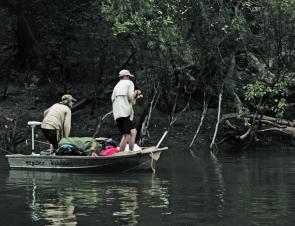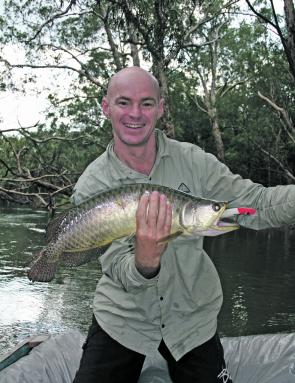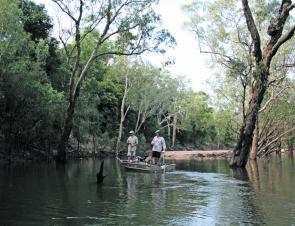The saratoga (Scleropages leichardti) has long been forgotten by many anglers but in the picturesque rivers of Queensland, the wild river toga are cunning predators that rate as my number one freshwater sportfish.
There are two species of saratoga; a northern and a southern species.
The southern species can be found around Central and Southern Queensland in the Fitzroy/Dawson River systems. They are also found in many of the stocked impoundments where they exhibit almost identical behaviours to their wild river cousins. The southern saratoga has bred well in the dams and can be found as far south as the Hinze Dam on the Gold Coast.
The northern saratoga is found in the rivers of Cape York, Northern Territory and into Western Australia, as well as PNG. I have caught saratoga in the Wenlock and the Archer Rivers, and also know there are a large population of the northern species in the Jardine.
I’ve learnt a lot about this awesome sportfish and have started catching them in good numbers by getting well upstream during the dry season. Just how I go about catching large numbers of saratoga is a story in itself.
My mates and I rigged up small electric powered tinnies that can drift through the river during the last of the wet season run-off and, when the river slows, the fishing becomes a lot easier and a lot more productive. We generally spend a number of days drifting around 100km of river. This is done with some generous help from friends who drop us off in the middle of Cape York and pick us up a number of days later.
There are easier ways to catch toga but not in the numbers and in the untouched surroundings that we experience on these trips. The only thing that improves the scenery is a fired up saratoga heading into a snag or launching itself skyward in an attempt to throw the hooks.
Just one look at the fish will tell you a lot about its habits. The huge upturned mouth and big eyes looking up and positioned right on top of the head indicates that they are a top water feeder. They look like a cross between an archer fish and a barramundi.
They live in snags and overhanging vegetation but also love shallow, calm backwaters out of the flow of the river. On our last trip to Cape York we spent a few days drifting the rivers and just about every little pool we found out of the flow of the river, we managed to land a saratoga. I didn’t catch two out of the same pool, which leads me to believe that they may well prefer to hunt as a solitary fish.
I have read up about toga and most research indicates that they prefer to feed on bugs and other morsels that can be found on the surface, however you can’t convince me that a 70cm saratoga lives only on bugs. We often catch them on 120mm barra lures with the Qantas colour, red head and white body, being the definite winner.
During the dry season, the rivers of Cape York are filled with a fresh river prawn known as cherabin. They grow to the size of a king prawn but can be found in all sizes through the rivers and make up a huge part of the diet of all predator river species. It is for this reason that dark coloured soft plastics that imitate cherabin work extremely well.
For the visual effect, poppers and fizzers are also a good option but I have to say that plastics will always outfish surface lures. Having said that, you can’t beat watching a big toga smash a surface lure just before launching itself skyward as it feels the sting of the hooks.
Fly fishing would also be a good option. I am yet to get a toga on the wand and generally don’t bother targeting them due to being very average on the fly gear and having limited space to back cast on the densely vegetated rivers.
My fishing partner on our last trip used hardbodied lures to catch a lot of toga but the hard mouth, jumping and fighting qualities of the fish saw a number throw the hooks. A single hook rig, such as a soft plastic jighead, tends to keep a lot more attached. Leader of around 20lb is also needed for their hard, bony mouth. Most fish can be bought in on light tackle and I use 6lb mainline with a 20lb fluorocarbon leader.
I have never tried, but I have heard that there is no use trying to eat a toga. Apparently they are very bony and not worth the effort. A few quick snap shots and back into the water is the best option.
Fishing in the locations where you find northern saratoga gives you an appreciation for not only the fish but also the scenery. It is so well worth the effort to get on to one of the rivers of Cape York to try your luck on a wild river northern toga.
What’s in a name?
How the saratoga, originally known as barramundi, got its name is as legendary as the fish itself.
Barramundi is an aboriginal word meaning large scale, which certainly applied to the saratoga, and they were once plentiful in many northern rivers.
The Southern Queensland lungfish shared some similarities with the saratoga, especially the body shape and scales. With the scientific name of Neoceratodus forsteri, this was shortened to ceratodus but had many anglers calling it ‘ceratoga’. Over the years, this name has been mispronounced, misspelt and transferred from the lungfish to the saratoga.
Reads: 13318
Saratoga are not a good eating fish so take a few snap shots and throw them back in the water.

The hard mouth, jumping and fighting qualities of toga can cause a few thrown hooks. A single hook rig, such as a soft plastic jighead, is ideal.

Saratoga live in snags and overhanging vegetation but also love shallow, calm backwaters out of the flow of the river.

The huge upturned mouth and big eyes looking up and positioned right on top of the head indicates that toga are a top water feeder.

The only thing that improves the scenery is a fired up saratoga heading into a snag!




